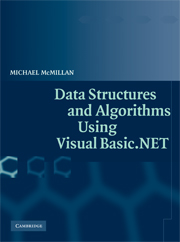Book contents
- Frontmatter
- Contents
- Preface
- Introduction
- Chapter 1 Collections
- Chapter 2 Arrays and ArrayLists
- Chapter 3 Basic Sorting Algorithms
- Chapter 4 Basic Searching Algorithms
- Chapter 5 Stacks and Queues
- Chapter 6 The BitArray Class
- Chapter 7 Strings, the String Class, and the StringBuilder Class
- Chapter 8 Pattern Matching and Text Processing
- Chapter 9 Building Dictionaries: The DictionaryBase Class and the SortedList Class
- Chapter 10 Hashing and the HashTable Class
- Chapter 11 Linked Lists
- Chapter 12 Binary Trees and Binary Search Trees
- Chapter 13 Sets
- Chapter 14 Advanced Sorting Algorithms
- Chapter 15 Advanced Data Structures and Algorithms for Searching
- Chapter 16 Graphs and Graph Algorithms
- Chapter 17 Advanced Algorithms
- References
- Index
Introduction
Published online by Cambridge University Press: 11 August 2009
- Frontmatter
- Contents
- Preface
- Introduction
- Chapter 1 Collections
- Chapter 2 Arrays and ArrayLists
- Chapter 3 Basic Sorting Algorithms
- Chapter 4 Basic Searching Algorithms
- Chapter 5 Stacks and Queues
- Chapter 6 The BitArray Class
- Chapter 7 Strings, the String Class, and the StringBuilder Class
- Chapter 8 Pattern Matching and Text Processing
- Chapter 9 Building Dictionaries: The DictionaryBase Class and the SortedList Class
- Chapter 10 Hashing and the HashTable Class
- Chapter 11 Linked Lists
- Chapter 12 Binary Trees and Binary Search Trees
- Chapter 13 Sets
- Chapter 14 Advanced Sorting Algorithms
- Chapter 15 Advanced Data Structures and Algorithms for Searching
- Chapter 16 Graphs and Graph Algorithms
- Chapter 17 Advanced Algorithms
- References
- Index
Summary
In this preliminary chapter, we introduce a couple of topics we'll be using throughout the book. First, we discuss how to use classes and object-oriented programming (OOP) to aid in the development of data structures and algorithms. Using OOP techniques will make our algorithms and data structures more general and easier to modify, not to mention easier to understand.
The second part of this Introduction familiarizes the reader with techniques for performing timing tests on data structures and, most importantly, the different algorithms examined in this book. Running timing tests (also called benchmarking) is notoriously difficult to get exactly right, and in the.NET environment, it is even more complex than in other environments. We develop a Timing class that makes it easy to test the efficiency of an algorithm (or a data structure when appropriate) without obscuring the code for the algorithm or data structures.
DEVELOPING CLASSES
This section provides the reader with a quick overview of developing classes in VB. NET. The rationale for using classes and for OOP in general is not discussed here. For a more thorough discussion of OOP in VB. NET, see McMillan (2004).
One of the primary uses of OOP is to develop user-defined data types. To aid our discussion, and to illustrate some of the fundamental principles of OOP, we will develop two classes for describing one or two features of a geometric data processing system: the Point class and the Circle class.
- Type
- Chapter
- Information
- Publisher: Cambridge University PressPrint publication year: 2005



